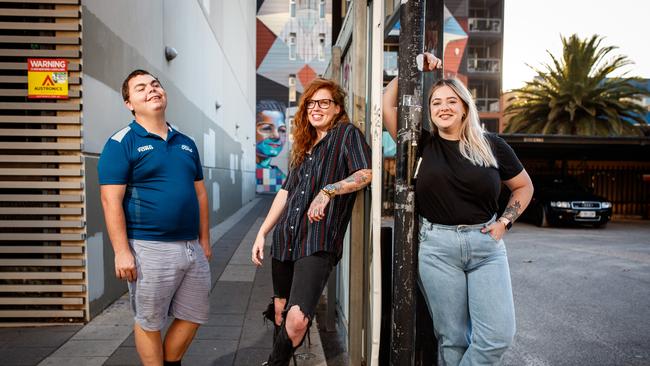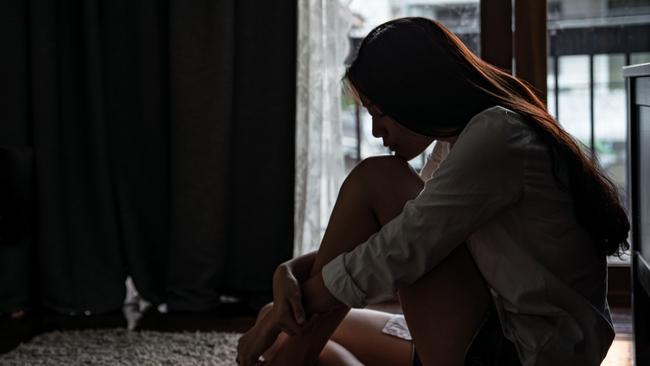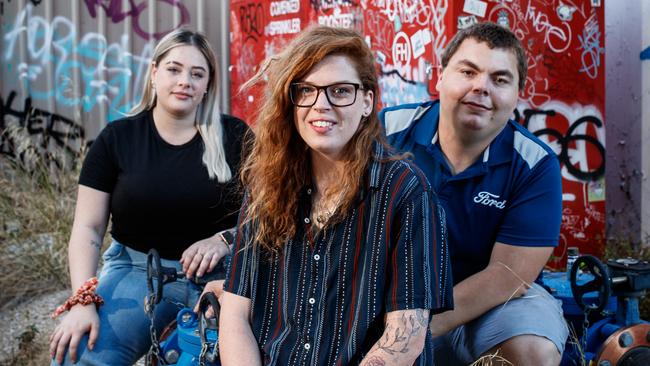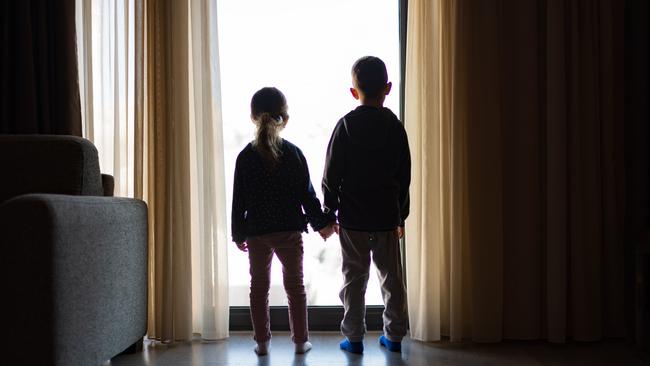State care: SA’s child protection system unmasked
Three young adults removed from their parents when they were children have lifted the lid on what life is like growing up inside SA’s child protection system.
SA Weekend
Don't miss out on the headlines from SA Weekend. Followed categories will be added to My News.
Brooke weighed just 930g when she was born, three months premature. Somewhere there is a photograph of her father’s palms cradling her in a hospital incubator.
“I fit into his hand, from my head to my feet,” she says, now 24.
But there is something even more unusual about that photograph. Around her father’s wrists are a set of handcuffs. He was in jail when she was born, in Western Australia where they lived at the time. “He was able to come out and see me,” Brooke says, “and then go back in.” Her mother was also in a bad way: aged 20, addicted to heroin and about to lose her second daughter to the child protection system.
“As soon as I was out of the womb there was an order put in place,” says Brooke, whose tiny body experienced drug withdrawal symptoms as she lay in the neonatal intensive care unit of a Perth hospital.
She was placed with a foster carer for the first year of her life but, when the woman passed away when Brooke was one year old, she went to live with her Nan. She was already looking after Brooke’s sister who is 11 months older and had also been removed from her mother’s care as a baby.
At the age of six, Brooke moved to South Australia with her Nan and later moved through a series of state care placements – with other extended family, foster carers or paid staff in government-run homes – and even spent some time back with her father in WA after he was released from jail.
Each year between 11,000 and 13,000 children are removed from unsafe parents around the country and taken into the care of the state. In SA, an average of about 730 children are taken into care for the first time each year, and there are currently about 4500 living with foster carers, relatives, in government homes or emergency accommodation.
But strict rules to protect the identity of children under guardianship, as they are known, mean they are rarely able to speak about their experiences in a system that can be both lifesaving and soul-destroying. It is only after they turn 18 that they can speak publicly about what it is like to grow up in state care. However, as we will see, this coming of age does not always mean the end of their struggles.

Brooke is one of three young adults who have spoken to SAWeekend out to give an insight into a system that often makes news headlines but is poorly understood. Children are removed from neglectful or abusive parents by the Child Protection Department in order to keep them safe. Chronic neglect is by far the most common reason, alongside domestic violence, substance abuse and mental illness.
In many hundreds of cases these children end up in homes with loving, willing carers who provide safety, stability and opportunities they otherwise would not have had. But successive royal commissions, coronial inquests and independent inquiries have repeatedly found that they can be at risk in the system too.
The crimes of pedophile former carer Shannon McCoole against children under guardianship sparked the 2016 Nyland Royal Commission. The 2012 death of Chloe Valentine – who was under the watch of social workers but left in the care of her mother and the man she was living with – led to a scathing coronial inquest. And last year revelations that two 13-year-old girls in care had run away and fallen pregnant sparked a review by former judge Paul Rice.
So what is it like to grow up under the guardianship of the government? How does it feel to be removed from your parents because they were incapable or unwilling to look after you? What is the daily routine in a house run by paid staff, working rotating shifts, who aren’t legally supposed to give you a hug?
Between them, the three young adults interviewed have experienced almost every type of care arrangement there is. Some things have changed in the years since they “aged out” of the system at 18, but many of their experiences remain the reality for children still inside.
Like Brooke, Nick, who is also now 24, was placed with a relative before entering a state-run home. Sonja, now 25, lived with a number of foster carers before having to move out on her own as a teenager. Today she has a good relationship with her mother and is getting to know her father, but her early years were unstable.
As a child, Sonja didn’t know who her father was, and her mother suffered from post-natal depression and other mental health concerns. “Having a newborn child and not having the support that she needed, it wasn’t a good place for her, and she was so young,” Sonja explains. “When she gave birth to me she knew that she wasn’t going to have me long-term. She felt it would be safer for me to go into care.”
By the time Sonja turned five, her mother’s mental health concerns reached a point where she decided to relinquish her to a foster carer whom she, but not Sonja, had met previously. “I remember when I was removed from my mum’s care I was asleep, and I woke up in a car with two people I’d never met and then I was taken to a pub, which is where the carer was for someone’s birthday,” she recalls. “That was the first time I’d ever met her. I was taken in the middle of the night … with nothing but the clothes on my back, which happens to a lot of kids.”
Sonja stayed with that woman for a couple of years before spending about a year each with two other, separate carers. She later returned to her original foster home where she stayed until she was 18. However, around that time, she says the living situation became untenable and she had to move in with friends.

Data shows South Australian children move between an average of at least three or four placements during their time in care, but in some cases it can run into double figures. In Brooke’s case, she was living in a state-run home when, at age 16, the department arranged for her to move into what is termed independent living in a public housing unit.
At first she was reluctant to leave the “security” of the state-run home, even though she “hated” living there much of the time, and says there was little support from workers once she was out on her own.
Nick had a smoother transition, largely due to support through the National Disability Insurance Scheme. He was diagnosed with autism as a teenager in care and when it came time to move out at 18 he was able to rent a two-bedroom unit through the Access to Place housing service. Nick also has regular visits from workers at disability provider CARA who help with cleaning, grocery shopping, socialising and managing his emotions.
“I’d hate to think what would have happened if the workers weren’t there. I probably would have lost the house within a year because I was never taught to clean properly,” he says.
Nick and his younger brother were removed from their mother, aged 12 and 10, after an incident in public that required police attendance. At the time she had undiagnosed mental health issues and the boys’ father had died when they were very young. The siblings were first placed with a relative but, after a couple of years, Nick was moved to a state-run home. It was there that he was diagnosed as being on the autism spectrum.
“One worker, their daughter was autistic too,” he explains. They spoke to my social worker and asked to get an assessment. We had a few workers who really looked after us, as kids, not just numbers.”

Reading about why these young people ended up in the care of the state, it would seem understandable if they wanted nothing to do with their parents. But all three say the pull of family remains incredibly strong. Last financial year, the department lodged more than 10,000 missing person reports about hundreds of children who repeatedly ran away. In the vast majority of cases it was to be back with family.
“At the end of the day we’ve had the shittest upbringing, we were removed for a reason, but we still crave that love and connection,” says Brooke.
Both Brooke and Sonja had the added loss of opportunity for cultural connection, being removed from their families with no understanding, at a young age, of their Aboriginal community. “I didn’t know my mob, I didn’t know anything about country or anything like that,” says Sonja, whose father’s family are Waanyi people from country in northwest Queensland. Sonja didn’t meet her father until recently and is “still trying to build that connection”. “It was in my file (when taken into care) saying I was Aboriginal but it didn’t say which mob, so it was a constant guessing game. Then I was placed into a white household,” she says. “I would ask about it but people wouldn’t really tell me. Even when I read my (government) file when I turned 18 a lot of it was blacked out.”
Similarly, Brooke describes herself as being “raised as a white fella”. “I was just this little red-haired, blue-eyed kid and I was like ‘are you sure’?” she says of learning while in care that she is Aboriginal. Brooke’s father is a Nyikina man, from country in the West Kimberley Region of WA. “I’m still learning all that stuff,” she says, adding that these days she has good relationships with siblings and extended family on her father’s side in WA.
Both young women say more needs to be done to help Aboriginal and Torres Strait Islander children who go into care to understand and remain connected to their family and culture.
A recent report by the Guardian for children in state care showed one in every 11 Aboriginal children in SA are living under guardianship. They account for a third of the 4500-odd children in care, despite making up less than 5 per cent of the general population.
And Guardian Penny Wright warns that fewer of them are being placed with Aboriginal family members, despite guidelines stating this should be the priority. Child Protection Minister Rachel Sanderson has acknowledged the “over-representation” of Aboriginal children in the system as “a nationwide issue” and listed measures put in place to address it in SA.
These include appointing April Lawrie as the state’s first Aboriginal Children’s Commissioner in late 2018, setting targets to recruit more Aboriginal staff in the Child Protection Department and delivering funding to more Aboriginal-controlled organisations to work with at-risk families.

Ms Lawrie has labelled claims that there are not enough Aboriginal people willing to become carers a “myth” and urged more consideration of extended family members. She has also called for more opportunities for young people in care to connect with their culture and tailored support for Aboriginal parents to address issues before they reach the point where a child must be removed. Latest data released by the department revealed at least 100 newborns are being taken from SA mothers by authorities each year – however it would not say how many were Aboriginal. Separate data shows an average of almost 70 babies a year in SA are born, like Brooke, showing symptoms of drug withdrawal.
When a relative or foster carer cannot be found to take in a child, the remaining option is to place them in a state-run home. Currently, about 580 young people in SA live in at least 170 of these houses, operated by departmental workers or non-government agency staff who work rotating shifts across 24 hours. Data consistently shows that young people in these homes have more complex trauma histories and health needs and are at greater risk of further harm while in care.
Brooke and Nick met for the first time when they were both placed in one of these homes, which housed up to eight young people. That home has since been closed, along with another large facility, following years of lobbying by child advocates. Most houses now host a maximum of four young people but some still have eight beds, and staff can change frequently, creating instability for residents.
In a bid to better address the trauma young people in these houses experience as a result of abuse or neglect, the government has committed $600,000 to introduce a new therapeutic model of care, known as the Sanctuary Model. It is supported by many advocates, including Guardian Penny Wright and Jacqui Reed, the chief executive of youth advocacy body The CREATE Foundation. “A move to therapeutic residential care is the way to go, to have workers with high-end skills,” Ms Reed, a former frontline child protection worker, says. Although she adds that it requires significant investment in training and recruitment.
Perhaps the biggest challenge comes when young people must leave these homes, or foster households. In many cases they continue to live with foster parents or relatives, however, not all carers are willing or can afford to do so. Until recently, financial support for carers in SA ended when a young person turned 18.
In January 2019, the state government extended payments to carers who continue to support a young person living with them full-time until the age of 21. However, this does not apply to those living in state-run homes.
For Sonja, the transition from a foster household to living independently was “very stressful”, and she says she didn’t complete year 12, in part, due to the upheaval. “You feel like you’re alone,” she says of that time.

A recent CREATE Foundation report found that about half of young people in state care around the country leave their carer’s home when they turn 18. Of the 325 young adults surveyed, 17 per cent found themselves immediately homeless when they “aged out” of their placement. Only a third of teens about to leave the system had a formal exit plan put in place and two-thirds had no contact with a case worker after leaving.
Ms Reed says the time when young people come to leave care is crucial. “I could cite dozens of cases (nationally) where young people get to 18 and they (authorities) haven’t got them on any housing list, or a plan to support them post care.” However, Ms Reed says SA is “probably more committed than many other states in the transition space”. As well as providing payments to age 21, the SA Government funds the CREATE Your Future program which trains child protection staff to help young people to gather the relevant information and gain necessary life skills to plan their move to independence.
However, simply having a history of being in state care can be the biggest barrier, making it hard to convince landlords that you’re a good rental prospect or employers to give you a go. This largely comes down to a stigma that is undeserved, say these care leavers.
“We’re portrayed as though we’re the issue, we’re the naughty kids and our parents couldn’t deal with us,” Brooke says. “Everybody thinks that we’re just these statistics, that we’re going to be incarcerated, that we’re going to be nothing.”
Sonja reveals the stigma often starts at school age. “When other kids find out you’ve been in care they think you’ve done something wrong. They would tease you. One kid even said to me ‘Nobody wants you, not even your own mother’,” she recalls.
“They don’t understand that kids are removed for their safety … or because their parents can’t provide for them.”
Despite wishing things had been different for them – and raising a host of ways the system could do better by the children it takes in – the trio acknowledge that the safety net is necessary. “When you’re younger you don’t really understand why you’re put into those situations but when you’re older you realise it’s safer for me to be where I’m at,” Sonja reflects.
Brooke describes the care system as “tough” and “pretty flawed” but acknowledges that “at the end of the day we were removed for a reason, because we were not safe”. “The system’s not always safe either, but it’s better than the alternative.”
Nick urges people to remember that the thousands of young South Australians living in state care are not just “numbers and statistics”. “We’d like to be heard as more than just government kids,” he says. “There’s a lot of us that have very good stories. We’re not all bad kids, we’ve just been put in bad situations. We’re making the best of what we got.”





